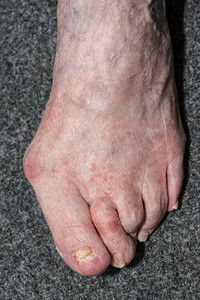 There are many reasons why a bunion may develop. This bony protrusion that can form on the side of the big toe can be the result of genetic factors, medical conditions that can include arthritis, or possibly from wearing shoes that do not fit correctly. These would include shoes that are snug in the toe area and may rub against the side of the big toe. A bunion is considered to be a bone deformity and a structural issue with the big toe. Many patients find that putting a pad over the bunion while wearing shoes may bring mild relief. In more severe cases, surgery may be a necessary option for permanent removal. This type of procedure is referred to as a bunionectomy. A common practice that may be helpful in preventing bunions from developing is wearing shoes that have ample room for the toes to move freely in. If you have developed a bunion, please consult with a podiatrist who can perform a proper diagnosis and offer treatment options.
There are many reasons why a bunion may develop. This bony protrusion that can form on the side of the big toe can be the result of genetic factors, medical conditions that can include arthritis, or possibly from wearing shoes that do not fit correctly. These would include shoes that are snug in the toe area and may rub against the side of the big toe. A bunion is considered to be a bone deformity and a structural issue with the big toe. Many patients find that putting a pad over the bunion while wearing shoes may bring mild relief. In more severe cases, surgery may be a necessary option for permanent removal. This type of procedure is referred to as a bunionectomy. A common practice that may be helpful in preventing bunions from developing is wearing shoes that have ample room for the toes to move freely in. If you have developed a bunion, please consult with a podiatrist who can perform a proper diagnosis and offer treatment options.
If you are suffering from bunion pain, contact Shaun J. Limon, DPM and Lisa Griffith-Limon, DPM of Limons Foot & Ankle Care. Our doctors can provide the care you need to keep you pain-free and on your feet.
What Is a Bunion?
Bunions are painful bony bumps that usually develop on the inside of the foot at the joint of the big toe. As the deformity increases over time, it may become painful to walk and wear shoes. Women are more likely to exacerbate existing bunions since they often wear tight, narrow shoes that shift their toes together. Bunion pain can be relieved by wearing wider shoes with enough room for the toes.
Causes
- Genetics – some people inherit feet that are more prone to bunion development
- Inflammatory Conditions - rheumatoid arthritis and polio may cause bunion development
Symptoms
- Redness and inflammation
- Pain and tenderness
- Callus or corns on the bump
- Restricted motion in the big toe
In order to diagnose your bunion, your podiatrist may ask about your medical history, symptoms, and general health. Your doctor might also order an x-ray to take a closer look at your feet. Nonsurgical treatment options include orthotics, padding, icing, changes in footwear, and medication. If nonsurgical treatments don’t alleviate your bunion pain, surgery may be necessary.
If you have any questions, please feel free to contact our offices located in Bradenton and Lakewood Ranch, FL . We offer the newest diagnostic and treatment technologies for all your foot care needs.
Read more about Bunions